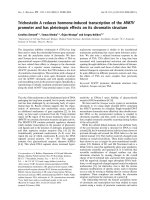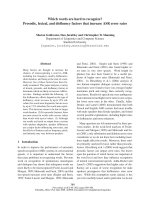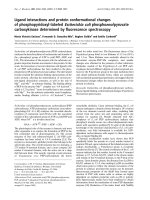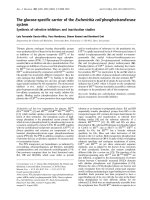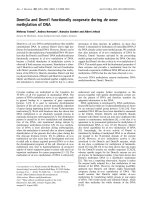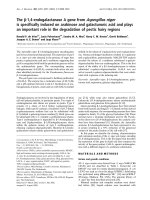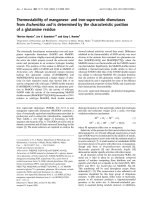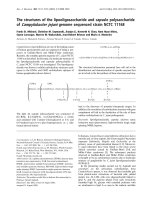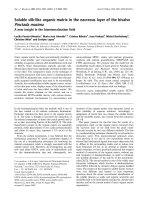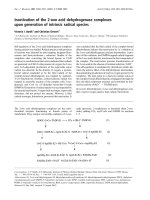Tài liệu Báo cáo Y học: Short peptides are not reliable models of thermodynamic and kinetic properties of the N-terminal metal binding site in serum albumin doc
Bạn đang xem bản rút gọn của tài liệu. Xem và tải ngay bản đầy đủ của tài liệu tại đây (315.31 KB, 9 trang )
Short peptides are not reliable models of thermodynamic
and kinetic properties of the N-terminal metal binding site
in serum albumin
Magdalena Sokolowska
1
, Artur Krezel
1
, Marcin Dyba
1
, Zbigniew Szewczuk
1
and Wojciech Bal
1,2
1
Faculty of Chemistry, University of Wroclaw, Poland;
2
Institute of Biochemistry and Biophysics, Polish Academy of Sciences,
Warsaw, Poland
A comparative study of thermodynamic and kinetic aspects
of Cu(II) and Ni(II) binding at the N-terminal b inding site of
human and bovine serum albumins (HSA and BSA,
respectively) and short peptide analogues was performed
using potentiometry and spectroscopic t echniques. It was
found that while qualitative aspects of i nteraction (spectra
and structures o f complexes, o rder of reactions) c ould be
reproduced, t he quantitative parameters (stability a nd rate
constants) could not. The N-terminal site in HSA is much
more similar to BSA than to short p eptides reproducing the
HSA sequence. A v ery strong influence of phosphate ions on
the kinetics of Ni(II) interaction was found. This study
demonstrates the limitations of short peptide modelling of
Cu(II) and Ni(II) transport by albumins.
Keywords: serum albumin; copper(II); nickel(II); binding
constants; rate constants.
Human s erum albumin (HSA) is t he most abundant protein
of blood serum, at concentration of 0 .63 m
M
(% 4%) [1].
It is a v ersatile carrier protein, involved i n the transport of
hormones, vitamins, fatty acids, xenobiotics, drugs and
metal ions, including physiological Ca
2+
,Zn
2+
,Co
2+
and
Cu
2+
, as well as toxic Cd
2+
and Ni
2+
[1–3]. This variety of
functions is made possible by t he presence of many binding
sites on the surface of the HSA molecule, including
hydrophobic pockets of various sizes a nd shapes and
coordination domains equipped with sets of donor groups
appropriate for particular metals. Among the latter, the
N-terminal binding site for Cu
2+
and N i
2+
ions has been
characterized particularly w ell. It is composed of the first
three amino-acid residues o f the HSA sequence, Asp-Ala-
His, and the resulting square-planar complex exhibits a
unique coordination mode with deprotonated amide
nitrogens of Ala and His residues, in addition to the
N-terminal amine and the His imidazole donor (the
so-called 4N complex, s ee Fig. 1) [4–7]. Structural s tudies
on various peptide analogues in the solid state [8–10] and in
solution [11,12], as well as numerous spectroscopic works
confirmed that such coordination style is a common feature
of peptides having N-terminal sequences of the X-Y-His
type (reviewed in [13]). As such, it is shared by many
mammalian a lbumins, which differ from HSA at positions 1
and/or 2, but not 3 (e.g. bovine serum albumin, BSA,
contains the s equence A sp-Thr-His) [ 14–17]. In a lbumins
from several species, i ncluding dog (DSA) and pig (PSA),
the H is3 r esidue is replaced by Tyr. This, and an y other
mutation r emoving His from position 3, results in a lack of
affinity and specificity for Cu(II) and Ni(II) binding at the
N-terminus [7,16,18,19].
Recently, we have reported the existence o f the second
specific binding site for Cu(II) in HSA and BSA, which also
shares spectroscopic similarities with a PSA site [20]. W e
named it Ômultimetal binding siteÕ, because it can bind
Ni(II), Z n(II) and C d(II) with sim ilar affinities. B ased on
information from
113
Cd NMR studies [21] and HSA
crystallography [2,22], t his site was located a t the interface
of domains I a nd II of HSA and BSA, where His67 and
His247 are present on the protein surface, adjacent to each
other. This site is at a distance of % 16.5 A
˚
from Ser5, t he
first N-terminal residue seen in electron density maps. For
simplicity, the N-terminal site will be labelled Ôsite IÕ and the
multimetal binding site Ôsite IIÕ throughout the text. The
analysis of binding constants obtained from CD-monitored
metal ion titrations indicated that site II may have
physiological relevance for Ni(II), Zn(II) and Cd(II). This
finding is of particular interest for the yet unrecognized
process of blood transport of toxic and carcinogenic nickel.
It has been established that the Ni(II) complex at site I
provides the a ntigenic moiety i n nickel allergy [23,24], but
little is known about the redistribution of nickel from blood
Correspondence to W. Bal, Faculty of Chemistry, University of
Wroclaw, ul. F. Joliot-Curie 14, 50-383 Wroclaw, Poland.
Fax: + 48 71 328 2348, Tel.: + 48 71 3757-281,
E-mail:
Abbreviations:HSA,humanserumalbumin;BSA,bovineserum
albumin; 4N complex, c omplex with f o ur-nitrogen co ordination of th e
central metal ion.
Definitions of constants: b ¼ [M
i
H
j
L
k
]/([M]
i
[H]
j
[L]
k
), overall
complex stability constant; *K ¼ b(MH
-j
L)/b(H
n
L), the equilibrium
constant of actual complex formation: M + H
n
L ¼ MH
-j
L+
(n+j)H
+c
K ¼ [M
c
L]/([M] [
c
L]), conditional affinity c onstant,
where
c
L contains all protonation forms at a given pH;
i
K
M
¼
c
K for
the metal binding at the i-th site of serum a lbumin,
i ¼ 1 or 2, corresponding to site I or II, M is Cu(II) or Ni(II) [20];
K
r
¼
2
K
Cu
/
2
K
Ni
; relative affinity constant at site II; k
obs
¼ apparent
1st order kinetic constant.
(Received 11 July 2001, revised 16 November 2001, accepted 9 January
2002)
Eur. J. Biochem. 269, 1323–1331 (2002) Ó FEBS 2002
to organs in which it can exert procarcinogenic lesions [25].
In order to approach the issue of Cu (II) and Ni(II) exchange
by albumin, we characterized the binding parameters and
performed parallel kinetic studies using HSA and BSA and
three simple analogues of the N-terminal binding site. These
were: Asp-Ala-His-NH
2
(DAHam) and Asp-Ala-His-Lys-
NH
2
(DAHKam), which represent the native HSA
sequence and Val-Ile-H is-Asn ( VIHN), t he N-terminal
peptide o f another blood serum protein, d es-angiotensino-
gen [11]. The structure of the Ni(II) complex of the latter
contains a specific steric shielding, resulting in a particularly
slow kinetics of Ni(II) dissociation. Somewhat surprisingly,
we found that, despite the identical mode of coordination,
important thermodynamic and kinetic p arameters of Cu(II)
and Ni(II) interactions could not be reproduced quantita-
tively by short peptides. The present paper presents the
results of our studies.
MATERIALS AND METHODS
Materials
NiCl
2
and CuCl
2
were purchased from Fluka. HNO
3
,
KNO
3
, EDT A, dimethylg lyoxime and ethanediol w ere
obtained from A ldrich. Tris/HCl, mono- and disodium
phosphates were purchased from Merck. Homogeneous,
high purity defatted HSA and BSA [6] a nd Val-Ile-His-Asn
(VIHN) peptide were obtained from Sigma. Peptide Asp-
Ala-His-NH
2
(DAHam)wasagiftofHenrykKozlowski,
Faculty of Chemistry, University of Wroclaw. Stock
solutions of NiCl
2
and CuCl
2
were standardized gravimet-
rically with dimethylglyoxime and complexometrically with
EDTA, respectively. Concentrations of stock solutions of
HSA and BSA were estimated spectrophotometrically at
279 n m [6] and by Cu(II) titrations (see be low). Purities of
both peptides were determined by potentiometric titrations
to exceed 98%.
Peptide synthesis
The N-Fmoc-protected amino acids and Fmoc Rink
amide MBHA resin were obtained from Nova Biochem
(Calbiochem-Novabiochem AG, La
¨
ufelfingen, Switzer-
land). Benzotriazol-1-yloxytris(dimethylamino)phospho-
nium hexafluorophosphate (BOP) was purchased from
Chem-Impex International (Chem-Impex International,
Wood Dale, IL, USA). Trifluo roacetic acid, piperidine,
N,N-dimethylformamide (DMF) and N,N-diisopropyleth-
ylamine (DIPEA) were obtained f rom Riedel – de Hae
¨
n
(Riedel-de Hae
¨
n GmbH, Seeize, Germany). Acetic anhy-
dride (Ac
2
O) was obtained from POCh (POCh S.A.,
Gliwice, Poland). Triisopropylsilane (TIS) was o btained
from Lancaster ( Lancaster Synthesis GmbH, Mu
¨
hlheim
am Main, Germany). Acetonitrile (HPLC grade) was
obtainedfromJ.T.Baker(J.T.Baker,Deventer,the
Netherlands).
The peptide Asp -Ala-His-Lys-NH
2
was synthesized by
Fmoc strategy on solid support [26–28] using Rink a mide
MBHA resin. Fmoc protection groups were removed by
25% p iperidine i n DMF. The N-Fmoc-amino acids
(3 equiv.) were co upled by BOP (3 equiv.)/DIPEA (6 equiv.)
procedure [27]. Coupling reaction was monitored by Kaiser
(ninhydrin) test [27,28]. After coupling reactions acetic
anhydride (3 equiv.)/DIPEA (6 equiv.) in DMF was used f or
capping of unreacted peptides chains. C leavage w as effected
using a mixture of trifluoroacetic acid, H
2
O, and TIS
(v/v/v ¼ 95/2.5/2.5) over a period of 2.5 h , followed by
precipitation with diethyl ether [28]. The crude peptides were
purified by preparative HPLC on the Alltech Econosil C18
10 U column (Alltech Associate, Inc., Deerfield, IL, USA),
5-lm particle size , 2 2 · 250 mm, eluting with 0.1%
trifluoroacetic acid/water at a flow rate of 7 mLÆmin
)1
with
detection at 223 nm. Fractions collected across the main
peak were assessed by HPLC analysis on Beckman Ultra-
sphere ODS C 18 column (Beckman Instruments, Inc.,
Fullerton, CA, USA), 5-lm particle size, 4.6 · 250 mm,
eluting with 0.1% trifluoroacetic acid/water (solvent A) and
0.1% trifluoroacetic a cid/80% acetonitrile/water ( solvent
B), using a gradient of 0% B to 100% B over 60 min at flow
rate of 1 mLÆmin
)1
and d etection at 223 nm. Correc t
fractions were pooled and lyophilized to yield with solid of
purity exceeding 99% as assessed by HPLC analysis of the
final m aterials. I dentity and purity of peptide was confirmed
by mass spectrometry, utilizing a Finnigan MAT TSQ 700
(Finnigan MAT, San Jose, CA, USA) mass spectrometer
equipped with a Finnigan electrospray ionization source.
The m/z values found/calculated were 468.8/469.2
(M + H)
+
and 234.9/235.1 (M + 2H)
2+
.
Potentiometry
Potentiometric titrations of VIHN, DAHKam, their com-
plexes with Cu(II), as well as the DAHKam complex
with Ni(II) in the presence of 0.1
M
KNO
3
were performed
at 25 °C over the pH range 3–11.5 (Molspin automatic
titrator) with 0 .1
M
NaOH as titrant. Changes in pH were
monitored with a combined glass-Ag/AgCl electrode
(Russell) calibrated daily in hydrogen ions concentrations
by HNO
3
titrations [29]. S ample v olumes o f 1.5 mL, with
peptide concentrations of 1 m
M
and peptide molar excess
over metal ion of 1.1–1.5 were used. The titration data were
analysed using the
SUPERQUAD
program [30]. Standard
deviations computed by
SUPERQUAD
refer to random errors
only.
CD spectroscopy
The spectra were recorded at 25 °ConaJascoJ-715
spectropolarimeter, over the range of 240–800 nm, using
1 c m c uvettes. The spectra are expressed in terms of
Fig. 1. Scheme of 4N coordination mode in XYH peptides, M is Cu(II)
or Ni(II).
1324 M. Sokolowska et al. (Eur. J. Biochem. 269) Ó FEBS 2002
De ¼ e
l
) e
r
,wheree
l
and e
r
are molar absorption
coefficients for left and right circularly polarized light,
respectively. 1 m
M
peptide solutions and peptide molar
excess over metal ion of 1.1 we re used for pH titrations,
while 0.5 m
M
peptide samples were used for kinetic
measurements. Concentrations of albumin samples were
0.5 m
M
in protein, with varied metal ion amounts. The
albumin samples for titrations and metal exchange
kinetics measurements were kept at pH 7.4 (100 m
M
sodium phosphate buffer). The kinetics of metal binding
to peptides and their exchange was studied in 100 m
M
Tris/HCl and in 100 m
M
phosphate buffers, both at
pH 7.4.
UV–Vis spectroscopy
The kinetics of Ni(II) binding to DAH-am a nd substitution
by Cu(II) in 100 m
M
phosphate buffer, pH 7.4 at 25 °Cwas
studied on a Beckman DU-650 spectrophotometer, using
monitor wavelength of 420 nm, and sampling interval of
5 s . For control purposes the spectra were also recorded in
the range of 300–900 nm before and after reaction. In a
separate experiment, a titration of DAHK-am with Ni(II)
was performed, also monitored at 420 nm. All other
experimental details were analogous to those used in CD
spectroscopy.
EPR
The X-band EPR spectra of Cu(II) complexes of VIHN
and DAHKam were obtained at 77 K (liquid nitrogen) on
a Bruker ESP-300 spectrometer, using Cu(II) concentra-
tions of 3 m
M
and Cu(II)-to-peptide ratios of 1 : 1.
Ethanediol aqueous solution (30% v/v) was used as solvent
for these measurements to ensure homogeneity of t he
frozen samples.
RESULTS
Complexation of Cu(II) and Ni(II) by model peptides
and albumins
Among the systems under s crutiny in this w ork, the Ni(II)
complexes of VIHN [11] and the DAHam complexes of
Cu(II) and Ni(II) [31] were studied previously. Tables 1 and
2 thus present only the novel data: protonation constants
for DAHKam and VIHN, and stability constants (log a
values) of Cu(II)-VIHN, Cu-DAHKam and Ni-DAHKam
systems. The parameters of CD and EPR spectra of all
major complexes present at pH 7 .4 are provided i n Table 3.
Table 1. Protonation constants (log b values) f or peptides at I =0.1
M
(KNO
3
) and 25 °C. Standard deviations on the l ast digits are given in
parentheses.
Species DAHKam VIHN
HL 10.52(2) 7.92(2)
H
2
L 18.05(2) 14.48(2)
H
3
L 24.32(2) 18.37(3)
H
4
L 27.16(3)
Table 3. Parameters of CD and EPR spectra of 4N complexes of peptides and albumins at pH 7.4 and 25 °C.
Compound
CD Ni(II) CD Cu(II) EPR Cu(II)
k (nm) De (
M
)1
Æcm
)1
) k (nm) De (
M
)1
Æcm
)1
)Ai(Gs) gi
VIHN 475 ()1.33) 552 ()0.72) 206 2.18
407 (+0.65) 477 (+0.34)
271 (+1.35) 315 (+1.33)
261 (+1.56) 275 ()2.50)
DAHam
a
475 ()1.66) 561 ()0.95) 205 2.18
409 (+1.05) 485 (+0.53)
263 (+1.32) 306 (+1.40)
270 ()2.79)
DAHKam 475 ()1.90) 567 ()0.46) 200 2.19
410 (+1.61) 489 (+0.48)
267 (+1.04) 308 (+0.72)
270 ()1.99)
HSA
b
476 ()1.38) 565 ()0.54) 207 2.18
410 (+1.19) 486 (+0.49)
307 (+0.96)
BSA
b
479 ()1.79) 559 ()0.94) 200 2.18
410 (+1.11) 480
310
(+0.40)
(+1.42)
a
EPR data from [31].
b
EPR data from [20].
Table 2. Stability constants (log b values) o f Ni(II) and Cu(II) com-
plexes of peptides at I =0.1
M
(KNO
3
) and 25 °C. Standard devi-
ations on the last digits are given in parentheses.
Species DAHKam-Ni DAHKam-Cu VIHN-Cu
MH
2
L 21.48(3) 23.15(6)
ML 10.04(3) 14.18(3)
MH
-1
L 4.84(1) 9.88(2)
MH
-2
L )5.21(1) )0.32(3) )1.15(1)
Ó FEBS 2002 Peptides fail to model N-terminal albumin site (Eur. J. Biochem. 269) 1325
The CD spectra for DAHam co mplexes at pH 7.4 were
re-measured to assure full correspondence with kinetic
experiments. Figure 2 presents potentiometric speciation
diagrams for Cu(II)-VIHN, Cu-DAHKam and Ni-DAH-
Kam syste ms, with relative CD intensities of the d–d bands
of major 4N complexes overlaid (taken as De
ext
of the higher
energy component minus De
ext
of the lower-energy compo-
nent). The e xcellent agreement between t hese two inde-
pendent measures of complex formation confirms the
validity of the results.
CD spectra of albumins were found to be in good
agreement with previous determinations, p erformed in the
absence of buffers [20]. The application of 100 m
M
phos-
phate buffer at pH 7.4 (which conserves native conforma-
tions of the p roteins) for albumin studies resulted in weak,
but noticeable competition for Ni(II) binding at site I and
Cu(II) binding at site II. No evidence of formation of
ternary complexes was found. Also, no precipitation of
metal phosphates o r hydroxides occurred. Titration curves
were obtained from the corresponding CD spectra, which
allowed for calcu lations of appropriate conditional a ffinity
constants. This is illustrated in Fig. 3 for Ni(II) binding at
site I of HSA. Because of t he slowness of Ni(II) binding at
site I (see below), but not at site II, the equilibration of
reaction at each point of Ni(II) titrations had to be a ssured
by recording the spectra periodically. Quantitation of sites I
and II (and thus of albumin concentrations) could be
obtained f rom C u(II) titrations, as described in our previous
paper [20]. In agreement with previous reports [20,32], the
deficit of site I (25%) was found for HSA, but not for BSA.
The binding constants for Ni(II) at site II were obtained
from K
r
, relative constants, describing Cu(II)/Ni(II) com-
petition at site II. For BSA this constant was m easured by
the method described previously [20], based on titrating
Cu(II) out of site II by Ni(II). This approach failed for HSA,
which partially precipitated at higher excess o f Ni(II).
Therefore, this constant was calculated from kinetic experi-
ments (see below). The
2
K
Ni
value for BSA was obtained
with site I occupied by Cu(II), and thus could be derived
directly from fitting the titration curves. The values of
2
K
Ni
constants were applied to calculate relative occupancies of
sites I and II in the course of Ni(II) titrations. Finally,
ÔintrinsicÕ protein constants were calculated w ith the use of
literature value s of protonation and stability constants for
phosphate complexes [33] These constants a re presented in
Table 4 .
An analogous titration was performed for Ni(II) com-
plexation by DAHKam, in 100 m
M
phosphate, pH 7.4,
using a bsorption spectra. This t itration yielded a linear
increase of complex concentration up to the saturation, thus
allowing for determination of ligand concentration, but n ot
for stability constant calculations. This b ehaviour is indic-
ative of a higher binding constant, making phosphate
competition negligible.
The kinetics of Ni(II) binding to model peptides and
albumins at pH 7.4 was also monitored by CD spectro-
scopy. I n t hese experiments, the equimolar amounts of
Ni(II) were added t o buffered p eptide or protein solutions in
one portion, with subsequent periodical recording of the
resulting CD spectra. The peptides were studied in both T ris
and phosphate buffers, to find out whether the buffer
components would affect the reaction rate. The reaction
endpoint was not affected, because Cu(II) and N i(II)
binding capabilities of both buffers at pH 7.4 are almost
identical to each other: log values of conditional affinity
constants (
c
K) of Tris complexes with Cu(II) and Ni(II),
Fig. 2. Speciation diagrams for VIHN-Cu(II) (A), DAHKam-Cu(II)
(B) and DAHKam-Ni(II) (C), calculated for 0.5 m
M
concentrations of
peptides and metal ions. The intensities of CD bands of 4N complexes
(constructed by adding intensities at extremes of d–d bands and
normalized to molar fractions) are overlapped as d symbols.
Fig. 3. Titration of site I in HSA with Ni(II) ions at pH 7.4 in 100 m
M
phosphate buffer. d, experimental points constructed by adding
intens it ies at extr e mes of d–d bands, 475 and 410 nm . Lines are fit to
the conditional binding constant of Ni(II) at site I.
1326 M. Sokolowska et al. (Eur. J. Biochem. 269) Ó FEBS 2002
calculated from d ata in [34], are 3.4 and 1 .9, respectively, v s.
3.1 and 2.0 for analogous phosphate complexes [33].
In all cases 1st order kinetic curves were seen. Table 5
presents the corresponding constants k
obs
, obtained by least-
square fitting of the curves generated usin g several reporter
wavelengths, c orresponding to spectral extrema. Examples
of the spectra and kinetic plots are given for Ni(II) binding
to DAHKam and HSA (Fig. 4 ).
Finally, the reaction of Ni(II) removal from site I by C u(II)
was studied for peptides [saturated at N i(II)-to-peptide 1 : 1]
and for albumins [in the presence of 1 .5-fold molar excess of
Ni(II) over site I, to assure its saturation]. The total amounts
of Cu(II) and Ni(II) were matched in these measurements. In
a s eparate experiment, HSA saturated with Cu(II) at both
sites was the source of Cu(II) competing for DAHKam
saturated w ith N i(II). The spectra and kinetic plots for HSA
reaction are s hown in F ig. 5 .
DISCUSSION
Complex formation by model peptides
Potentiometric titrations and parallel CD and EPR spec-
troscopic measurements confirm that m ajor complexes
formed by peptides studied are typical 4N co mplexes of
the structure presented in Fig. 1 . For VIHN and DAHam
Table 4. Binding constants (log v alues) for Cu(II) and Ni(II) complexes of albumins i n 0.1
M
phosphate buffer, pH 7.4, at 25 °C. Standard deviations
on the last digit are g iven in parentheses.
Albumin log
1
K
Ni
log
2
K
Ni
a
log
2
K
Cu
log K
r
log(
1
K
Ni
/
2
K
Ni
)
HSA 6.8(3) 4.9(3) 7.1(2) 2.18(5) 1.9(3)
BSA 6.69(8) 4.60(5) 6.20(3) 1.63(5) 2.09(8)
a
Derived from K
r
determined experimentally using
1
K
Ni
.
Table 5. Values of apparent 1 st order k inetic constants k
obs
(s
)1
) for Ni(II) binding a nd Ni(II) fi Cu(II) exchange for model peptides and albumins in
100 m
M
Tris and phosphate buffers at 25 °C. Standard deviations on the last digits are given in parentheses.
Compound
k
obs
(Ni + H
n
L fi NiH
-j
L) k
obs
(NiH
-j
L+CufiCuH
-j
L + Ni)
Tris Phosphate Tris Phosphate
VIHN 3.18(7) · 10
)4
1.17(3) · 10
)3
7(3) · 10
)7
2.1(2) · 10
)6
DAHam 1.72(5) · 10
)3
3.2(2) · 10
)2
1.17(3) · 10
)6
1.90(3) · 10
)3
DAHKam 5.8(1) · 10
)3
2.1(1) · 10
)2
9.2(8) · 10
)7
3.0(1) · 10
)5
BSA 2.56(7) · 10
)3
7.5(3) · 10
)5
HSA 2.7(1) · 10
)3
1.57(8) · 10
)4
HSA fi DAHKam 3.2(2) · 10
)5
Fig. 4. Kinetics of Ni(II) binding to DAHKam and HSA at pH 7.4 in 100 m
M
phosphate buffer. Left panel, kinetic plots (d,experimentalpoints
constructed by adding intensities at extremes of d–d bands, 47 5 and 410 nm, lines are fits to 1st order kinetics). Right p anel, the original CD spectra
of Ni(II)-DAHKam (top) and Ni(II)-HSA (bottom).
Ó FEBS 2002 Peptides fail to model N-terminal albumin site (Eur. J. Biochem. 269) 1327
they are represented by the MH
-2
L formula, where M is
Cu(II) or Ni(II). For DAHK there a re two such complexes,
MH
-1
L and MH
-2
L, differing by the protonation state of
the lysine amine, which is not involved in coordination. For
VIHN only the 4N species were detected, while potentio-
metric titrations indicated the presence of minor complexes
MH
2
L a nd ML for DAHKam. The actual existence of such
complexes in XYH peptides i s controversial [13,35], e.g. no
CD signature could be found for them. As indicated by
Fig. 2, these complexes, even i f existing at low pH, are not
present at pH 7.4, and therefore they were not taken under
consideration for kinetic experiments.
Spectroscopic data p resented in Table 3 (positions of CD
spectral extrema for Cu(II) and Ni(II) complexes, and EPR
parameters for Cu(II) species) indicate that 4N complexes of
all three peptides are very similar to each other. In
particular, the parameters for VIHN complexes do no t
deviate systematically from those of DAHam and
DAHKam. This means that the side chain carboxylate of
Asp1 does not have a direct effect on metal coordination
(in agreement with previous ob servations [6,7]). A slight
redshift of d –d bands accompanied by a subtle decrease of
delocalization of the unpaired d electron of t he Cu(II) ion in
the DAHKam complex, c ompared to DAHam may be due
to a tiny deviation from tetragonal symmetry caused by an
interaction b etween the p rotonated Lys side chain and the
His ring, observed previously in NMR studies of the Ni(II)
complex of HSA [6].
Due to different protonation patterns, the stability
constants of particular complexes of model peptides
cannot be compared d irectly. There are two ways of
circumventing this obstacle. One, allowing for compari-
sons of complexes with similar coordination modes and
different p rotonation stoichiometries, uses t he values of
*K, the equilibrium constant of the actual complex
formation reaction:
M þ H
n
L ¼ MH
Àj
L þðnþjÞH
þ
This constant represents the overall ability of ligand L to
form a given complex.
The other m ethod is to calculate the conditional affinity
constant at a given pH value,
c
K, corresponding to the
following formal reaction, which ignores ligand protona-
tion:
M þ
c
L ¼ M
c
L
where
c
L is t otal ligand concentration. This con stant is
useful for comparing stabilities of metal complexes with
dissimilar or not fully characterized ligands, such as
proteins, for which the accurate protonation information
is unavailable. Such comparisons are, however, limited to a
particular pH value.
Both sets of constants are given in Table 6 for our model
peptides and for related compounds. The cases of highest
and lowest affinities were se lected from literature data. The
binding affinities for t he model peptides a re in the middle of
the range of values f or both Cu(II) and Ni(II). Note t hat t he
variation of side chain substituents can result in changes of
complex stabilities by up to six orders of m agnitude, without
affecting the binding mode.
Kozlowski et al. have recently proposed to correlate the
stabilities of 4N complexes of Xaa-Yaa-His peptides,
expressed using *K constants, with the average basicities
of the nitrogen donors of the peptide [37]. The constants
measured in this work fall, however, below the correlation
line p roposed by them. This indicates that, while the
basicities of nitrogen donors, partially dictated by side
chains, i s an important factor in complex stability, the
outer sphere (steric) interactions also need to be
considered.
Comparison of Cu(II) and Ni(II) binding between
model peptides and albumins
Affinity for Ni(II) at site I can be compared between
albumins on one hand and DAHam and DAHKam on the
other. Much higher values were f ound for t he complexes of
model p eptides. This fact was confirmed by an a ttempt to
titrate DAHK-am with Ni(II) in 100 m
M
phosphate,
analogously to albumins. The titration curve was linear,
Fig. 5. Kinetics of Ni(II) substitution at site I of
HSA by C u(II) at pH 7.4 in 100 m
M
phosphate
buffer. Left panel, kinetic p lots of the loss of
Ni(II) complex (h, De at 410 nm), formation
of Cu(II) complex (s, De at 307 nm), and
buffering of Cu(II) at site II (d, De at 690 nm).
Right panel, the original CD spectra.
The arrows indicate directions of changes
at particular wavelengths.
1328 M. Sokolowska et al. (Eur. J. Biochem. 269) Ó FEBS 2002
indicating that the Ni(II) was bound to DAHK-am so
strongly that competition from phosphate was negligible.
The
c
K values for Ni(II) complexes of HSA and BSA are
still within the range provided by XYH peptides, but at its
lower end (Tables 4 and 6). No direct measurements of
Cu(II) affinities at site I have been reported so far, but
estimates based on equilibrium dialysis and other indirect
approaches, reviewed in [20], yield the log
1
K
Cu
value of
12–13, confirming the trend found for Ni(II). We can only
speculate on the reason of these differences, which might b e
due to different basicities of nitrogen donors at the protein
surface, limited accessibility of the binding site due to
shielding from the bulk of the protein, or some conform-
ational interactions. The metal-free DAHK sequence in
HSA has not been visualized in electron density maps,
apparently due to its mobility in the crystals [1,22]. This does
not necessarily exclude interactions of some kind between
the site I complex and other parts of the protein in solution,
which are in fact suggested by CD spectra (see below).
The comparison of CD sp ectra of complexes also points
toward slight differences in the conformation of the chelate
rings. The characteris tic alternate pattern of the d–d bands
in the C D s pectra is dictated by the c onformation o f the six-
membered chelate ring involving the His residue donors
(Fig. 1 ). This c onclusion is a direct consequence of the
presence of the same kind of spectrum for 4N complexes of
GGH, where the a carbon of the His residue is the sole
source of chirality [10]. However, while positions of the
component d– d bands and of CT transitions are relatively
constant, their absolute and relative in tensities depend quite
strongly on the n onbonding substituents in positions 1, 2,
and even 4 (Table 3). Moreover, the comparison with the
spectra of albumin c omplexes clearly indicates the influenc e
of the whole protein, which can only be t ransferred via the
limitation of conformational freedom of the complex
moiety. The CD spectra of HSA complexes are intermediate
between those of DAHam and DAHKam, suggesting that
the conformation of the chelate system in the protein is also
intermediate between these two models.
The Cu(II) stabilities at site II were measured directly, by
taking advantage from the presence of weakly competing
phosphate ions. The Cu(II)/Ni(II) competition at site II was
also studied. These experiments yielded binding values
clearly lower from those obtained previously in the absence
of buffer [20]. The
2
K
Cu
value decreased by % 0.5 log units,
while the K
r
values increased by 1–1.5 log units (with K
r
value for HSA still distinctly higher from that for BSA).
This translates i nto a hundredfold decrease of Ni(II) affinity
at site II in 100 m
M
phosphate buffer. It is possible that
clustered histidines (His67 and His247, presumably provi-
ding metal binding at site II and the neighbouring His242)
bind phosphate ions, thereby providing another level of
competition for metal ion binding.
Kinetics of Ni(II) binding and Cu(II)/Ni(II) exchange
The data presented in Table 5 demonstrate that the process
of Ni(II) binding has a uniform character f or model
peptides and for albumins. In all cases the apparent 1st
order kinetics was found for this bimolecular reaction. The
same reaction order was seen previously for the reverse
reaction of acid decomposition of complexes, studied in
detail for the Ni(II) complex of GGH [36,39]. The reason
for this is the common slow step of the rearrangement of
Ni(II) ion, between the high spin octahedral and the low
spin square planar forms. The latter is present in the 4N
complex, w hile the former in a ll other substrates/products in
either case [13,40].
VIHN formed the most sluggish c omplex in both buffers,
due to the additional step of side-chain folding [11]. The
DAHKam complex exhibited the highest rate of formation
in Tris, while DAHam reacted faster in phosphate. This
suggests an assistant role of the Lys side chain in Ni(II)
anchoring to DAHKam in Tris and its nonparticipation in
phosphate, likely due to the blocking by phosphate ions,
which would thereby compete with Ni(II). All the k
obs
values for peptides were increased i n the phosphate buffer.
The increase was t he most distinct f or DAHam. The
mechanism of c atalysis of acid decomposition of nickel
amine complexes by various compounds, including phos-
phates, was s tudied in detail [41]. In line with electrostatic
considerations presented there, this rate enhancement is
likely due to the facilitated anchoring of n eutral NiHPO
4
to
nitrogen donors of the peptide, compared to a positively
charged Ni(II)–Tris complex.
The rates of Ni(II) complexation by albumins in phos-
phate are 10-fold lower from t hose for DAHam a nd
DAHKam. This indicates that the metal-free DAHK
Table 6. Logarithmic values o f *K and
c
K constants for model peptides and other XYH pep tide analogues, representing the high-end and the l ow-end of
affinity series. The values of c onstants were calculated from appropriate s tability constants, using f ormulae provided in the Materials a nd methods
section.
Peptide
Log *K
a
Log
c
K
Cu(II) Ni(II) Cu Ni
VIHN
b
)15.63 )19.75 13.0 8.8
DAHam
c
)14.79 )20.02 13.7 8.5
DAHKam )14.44 )19.48 13.8 8.7
GGH
d
)16.43 )21.81 12.4 7.0
GGHist
e
)17.14 )22.65 11.7 6.2
HmSHmSHam
f
)11.05 )16.45 16.0 10.6
HP2
1)15
(RTHG-)
g
)13.13 )19.29 14.5 8.5
a
log *K ¼ log b(MH
-j
L) – log b(H
n
L), j and n ¼ 2, except for DAHKam, where j ¼ 1 and n ¼ 3.
b
Ni(II) data from ref [11].
c
[31].
d
[36].
e
glycylglycylhistamine, [9].
f
a-hydroxymetylseryl-a-hydroxymetylserylhistidinamide; Cu(II) data from [37]; Ni(II) data from [38].
g
N-Terminal 15-peptide of human protamine 2, [35].
Ó FEBS 2002 Peptides fail to model N-terminal albumin site (Eur. J. Biochem. 269) 1329
sequence in albumin is partially sh ielded from solution by
the rest of the protein. There is no correlation between the
complex stability and the rate of its formation.
The Ni(II) for Cu(II) exchange rates f or peptides are o f
the order of 10
)6
s
)1
in Tris (again somewhat slower for
VIHN, in accordance with the steric shielding of Ni(II)-N
bonds [11,42]). These rates are markedly slower from that
found for pure acid decomposition of the Ni(II)-GGH
complex given in [39] (k
d
¼ 8 · 10
)5
s
)1
). This, in
conjunction with 1st order kinetics, suggests that the
reaction of Ni(II) for Cu(II) exchange in T ris proceeds v ia
Ni(II) complex dissociation (slow step), followed by the
rapid formation of the Cu(II) species, and there is little
assistance from the buffer components. There is no accel-
eration for DAHKam, compared to DAHam, in accord-
ance with the lack of interaction between the Lys a mine and
Ni(II), once the 4N complex is formed.
The situation is quite different for phosphate solutions.
The rate for DAHKam i s now much lower from those of
albumins, and the reaction of DAHam is much faster.
The reaction rates for albumins and DAHam are higher
from the value for pure acid GGH dissociation. The
spread of rate constant values for the exchange r eaction in
phosphate is more than three orders of magnitude,
compared to just one order for Ni(II) binding. These
facts indicate that phosphate ions play a very specific r ole
in Ni(II) dissociation and Cu(II) binding, different for
each peptide. Note that the participation o f phosphate is
more likely to be of outer sphere character, because the
presence of isodichroic points b etween the s pectra of
substrate (NiH
-j
L) and product (CuH
-j
L) in reaction
mixtures points against a substantial formation of a
ternary complex with mixed coordination by either metal
ion.
The major difference between peptide a nd albumin
experiments i s in t he form of existence of Cu(II). While it
was p resent initially a weak phosphate complex in peptide
experiments, it was bound at site II in quasi-steady state in
albumin experiments (Fig. 5). This fact is confirmed by
calculations of the occupancy of site II by Cu(II) and Ni(II)
in the course of reaction, which yielded values of K
r
for
BSA identical to that obtained from direct titrations
(log K
r
¼ 1.65 ± 025 vs. 1.63 ± 0.05, respectively).
Despite this fact, the values of k
obs
for HSA and BSA,
very similar t o e ach other, are intermediate between those
for DAHam and DAHKam. This shows that the mechan-
ism o f m etal binding at site I i n a lbumin cannot be modelled
reliably by short peptides. The relatively fast rate of
exchange of Ni(II) for Cu(II) suggests the presence of
intramolecular Cu(II) transfer phenomenon in albumin. It
seems that a n unstructured (metal-free) site I cannot react
according to this putative mechanism, because the Ni(II)
binding reaction [which was in f act Ni(II) transfer from the
kinetically labile site II to site I] was tenfold slower for the
albumins than for both DAHam and DAHKam (Table 5).
The possibility of an intermolecular interaction was exclu-
ded by the experiment in which the target molecule was t he
external DAHKam Ni(II) complex, with site I of HSA
saturated with Cu(II). The rate constant measured in this
experiment was identical, within the experimental error,
with that obtained in the absence of albumin, and five times
lower from that obtained with HSA alone. The similarity o f
rates between HSA and BSA suggests that this process may
be common for a lbumins possessing site I . However, a
rather vague theory that the spectroscopic and kinetic (but
not even thermodynamic) properties of site I in HSA are
equally well (poorly) modelled by DAHam and DAHKam
peptides is as much as can be inferred from studies using
peptide models for site I.
CONCLUSIONS
Our s tudy demonstrated that the N-terminal s ite i n HSA is
much more similar to that of BSA than to short peptides
reproducing the HSA sequence. The albumins bind Cu(II)
and N i(II) distinctly weaker than the model p eptides. A very
strong influence of phosphate ions on Cu(II) and Ni(II)
binding at site II, as well as on kinetics of Ni(II) binding and
substitution by Cu(II) at site I was found, but no structure–
activity relationships between the binding sequence and
reaction rate could be e stablished. Our results clearly
demonstrate that short peptides cannot be reliably used
for i nterpretation and modelling of C u(II) and Ni(II)
transport by albumins. On the other hand, the direct
thermodynamic and kinetic characterization of Ni(II)
binding at site I in HSA and BSA was obtained. These
data can be very useful in further studies of the toxicolo-
gically relevant Ni(II)-albumin c omplex. It would be also
interesting to follow the indirect effects of physiologically
relevant Ca
2+
binding (which occurs at separate sites in the
protein [20,21]) on metal ion binding at site II.
ACKNOWLEDGEMENTS
The authors wish to thank Prof Henryk Kozlowski and Dr Piotr
Mlynarz for their kind g ift of peptide DAHam a nd for sharing the data
on its complexes prior to publication.
REFERENCES
1. Carter, D.C. & Ho, J.X. (1994) Structure of s erum a lbumin. Adv.
Protein. Chem. 45, 153–203.
2. He, X M. & Carter, D.C. (1992) Atomic structure and c hemistry
of human serum albumin. Nature 358, 209–214.
3. Peters,T. Jr (1985) Serum albumin. Prot. Chem. 37, 161–245.
4. Glennon, J.D. & Sarkar, B. (1982) Nickel (II) transport in human
blood serum. Biochem. J. 203, 15–23.
5. Laussac, J.P. & Sarkar, B. (1984) Characterization of the copper
(II) and nickel (II)-tran sport site o f human seru m albumin. S tudies
of copper (II) and nickel (II) bin ding to peptide 1–24 of human
serum albumin by
13
Cand
1
H NMR spectroscopy. Biochemistry
23, 2832–2838.
6. Sadler, P.J., Tucker, A. & Viles, J.H. (1994) Involvement of a
lysine residue in the N-terminus Ni
2+
and Cu
2+
binding site of
serum albumins. Comparison with Co
2+
,Cd
2+
,Al
3+
. Eur. J.
Biochem. 220, 193–200.
7. Valko, M., Morris, H., Mazu´ r, M., Telser, J., M cInnes, E.J.L. &
Mabbs, F.E. (1999) High-affinity binding site for copper (II) in
human and dog serum albumins (an EPR study). J. Phys. Chem. B
103, 5591–5597.
8. Camerman, N., Camerman, A . & Sarkar, B . (1976) Molecular
design to mimic the copper (II) transport site of human albumin.
The crystal and molecular structure of copper(II)-glycylglycyl-
L
-histidine-N-methyl amide mo noaquo c omplex. Can. J. Chem.
54, 1309–1316.
9. Gajda, T., Henry, B., Aubry, A. & Delpuech, J J. (1996) Proton
and metal ion interactions with glycylglycylhistamine, a serum
albumin mimicking pseudopeptide. Inorg. Chem. 35, 586–593.
1330 M. Sokolowska et al. (Eur. J. Biochem. 269) Ó FEBS 2002
10. Bal, W., Djuran, M .I., Margerum, D .W., Gr ay, E.T. Jr,
Mazid, M.A., Tom, R.T., Nieboer, E. & Sadler, P.J. (1994)
Dioxygen-induced decarboxylation and hydroxylation of
[Ni
II
(glycyl-glycyl-
L
-histidine)] occurs via Ni
III
: X-ray crystal
structure o f [Ni
II
(glycyl-glycyl-a-hydroxy-
D
,
L
-histamine)]3H
2
O.
J. Chem. Soc., Chem. Comm. 1889–1890.
11. Bal, W ., Chmurny, G.N., Hilton, B.D., Sadler, P.J. & Tucker, A.
(1996) Axial hydrophobic fence in highly stable Ni(II) co mp lex of
des-angiotensinogen N-terminal peptide. J. Am. Chem. Soc. 118,
4727–4728.
12. Bal, W., Wo
´
jcik, J., Maciejczyk, M., Grochowski, P. & Kasprzak,
K.S. (2000) Induction of a secondary structure in the N-terminal
pentadecapep tide of human protamine HP2 through Ni(II)
coordination. An NMR study. Chem. Res. Toxicol. 13, 823–830.
13. Kozlo wski, H., Bal, W., Dyba, M. & Kowalik-Jankowska, T.
(1999) Specific s tructure-stability relations in metallopeptides.
Coord. Chem. Rev. 184, 319–346.
14. Peters,T. Jr & Blumenstock, F.A. (1967) Copper-binding pro-
perties of b ovine serum albumin and its a mino-terminal peptide
fragment. J. Biol. Chem. 242, 1574–1578.
15. Appleton, D.W. & Sarkar, B. (1971) The absence of specific
copper (II) -binding site in dog albumin. J. Biol. Chem. 246, 5040–
5046.
16. Callan, W.M. & Sunderman, F.W. Jr (1973) Species variations i n
binding of
63
Ni(II) by serum albumin. Res. Comm. Chem. Pathol.
Pharmacol. 5, 459–472.
17. Laurie, S.H. & Pratt, D.E. (1986) A spectroscopic study of
nickel (II)–bovine serum albumin binding and r eactivity. J. Inorg.
Biochem. 28 , 431–439.
18. Rakhit, G. & S arkar, B. (1981) Electron spin resonance study of
the c opper (II) complexes of human and dog serum albu mins and
some peptide analogs. J. Inorg. Biochem. 15, 233–241.
19. Predki, P.F., Harford, C., Brar, P. & Sarkar, B. ( 1992) Further
characterization of the N-terminus copper (II) and nickel
(II) -binding motif o f proteins. Studies of metal binding to c hicken
serum albumin and the native sequence peptide. Biochem. J. 287,
211–215.
20. Bal, W ., Christodoulou, J., Sadler, P.J. & Tucker, A. (1998) Multi-
metal binding site of serum albumin. J. Inorg. Biochem. 70, 3 3–39.
21. Sadler, P.J. & Viles, J.H. (1996)
1
Hand
113
Cd NMR investigations
of Cd
2+
and Zn
2+
binding sites on serum albumin: competition
with Ca
2+
,Ni
2+
,Cu
2+
and Zn
2+
. Inorg. Chem. 35, 4490–4496.
22. Sugio, S., Kashima, A., Mochizuki, S., Noda, M. & Kobayashi,
K. (1999) Crystal structure of human serum albumin at 2.5 A
resolution. Protein Eng. 12 , 439–446.
23. Dolovich, J., Evans, S.L. & Nieboer, E. (1984) Occupational
asthma from nick el sensitivity. I. Human serum albumin i n the
antigenic determinant. Br.J.Ind.Med.41, 51–55.
24. Patel, S.U., Sadler, P.J., Tucker, A. & Viles, J.H. (1993 ) Direct
detection of albumin in human blood plasma by
1
H NMR spec-
troscopy. Complexation of nickel (II). J. Am. Chem. Soc. 115,
9285–9286.
25. Kasprzak, K.S., Jaruga, P., Zastawny, T.H., North, S.L., Riggs,
C.W., Olinski, R. & D izdaroglu, M. (1997) Oxidative DNA base
damage and i ts repair in kidneys and livers of n ickel (II) -treated
male F344 rats. Carcinogenesis 18, 271–277.
26. Meienhofer, J., Waki, M., Heimer, E.P., Lambros, T.J.,
Makofske, R.C. & Chang, C.D. (1979) So lid phase synthesis
without repetitive hydrolysis. Preparation o f leucylalanyl-glycyl-
valine using 9-fluorenylmethyloxy- carbonylamino acids. Int.
J. Peptide Protein Res. 13, 35–42.
27. Fields, G.B., ed. (1997) Solid-Phase Peptide S ynthesis. Methods
Enzymol. 289. Academic Press, New York.
28. Chan, W.C. & White, P.D., eds. (2000) Fmoc Solid P hase Peptide
Synthesis. A P ractical Approach. Oxford University Press, N ew
York.
29. Irving, H., Miles, M.G. & Pettit, L.D. (1967) A study of some
problems in determining the stoichiometric proton dissociation
constants of complexes by potentiometric titrations using a glass
electrode. Anal. Chim. Acta 38, 475–488.
30. Gans, P., Sabatini, A. & Vacca, A. (1985) SUPERQUAD: an
improved general program for computation of formation con-
stants from potentiometric data. J. Chem. Soc. Dalton Trans.
1195–1199.
31. Mlynarz, P., Valensin, D., Kociolek, K., Zabrocki, J ., Olejnik, J. &
Kozlowski, H. (2002) Impact of the peptid e seq uence on the
coordination abilities of albumin-like tripeptides t owards Cu
2+
,
Ni
2+
and Zn
2+
ions. Potential alb umine-like p eptide c helators.
New. J. Chem. 26, in press.
32. Chan, B., Dodsworth, N., Woodrow, J., Tucker, A. & Harris, R.
(1995) Site-specific N-terminal auto -degradation o f human s erum
albumin. Eur. J. Biochem. 227, 524–528.
33. Banerjea, D., Kaden, T. & Sigel, H. (1981) Enhanced stability of
ternary complexes in solution through the participation of
heteroaromatic N bases. Comparison of the coordination
tendency of pyridine, imidazole, ammonia, acetate, and hydrogen
phosphate toward metal ion nitrilotriacetate complexes. Inorg.
Chem. 20, 2586–2590.
34. Fischer, B., Haring, U ., Tribolet, R. & Sigel, H. (1979) Metal ion/
buffer interactions. Stability of binary and ternary complexes
containing 2-amino-2(hydroxymethyl)-1,3-propanediol (Tris) and
adenosine 5¢-triphosphate (ATP). Eur. J. Biochem. 94, 523–530.
35. Bal, W., Jezowska-Bojczuk, M. & Kasprzak, K .S. (1997) Binding
of nickel (II) a nd copper (II) to the N-terminal sequence of human
protamine HP2. Chem. Res. Toxicol. 10, 906–914.
36. Hay, R.W., Hassan, M.M. & Quan, C.Y. (1993) Kinetic and
thermodynamic studies of the c opper (II) an d nickel (II) com-
plexes of glycylglycyl-
L
-histidine. J. Inorg. Biochem. 52, 17–25.
37. Mlynarz, P., Bal, W., Kowalik- Jankowska, T., Stasiak, M.,
Leplawy, M.T. & Kozlowski, H. (1999) Introduction of
a-hydroxymethylserine residues in the peptide sequence results in
the strongest peptidic copper (II) ch elator known to d ate. J. Chem.
Soc. Dalton Trans. 109–110.
38. Mlynarz, P., Gaggelli, N., Panek, J., Stasiak, M ., Valensin, G.,
Kowalik-Jankowska, T., Leplawy, M.L., Latajka, Z. &
Kozlowski, H. (2000) How the a-hydroxymethylserine residue
stabilizes oligopeptide complexes with nickel (II) and copper (II)
ions. J. Chem. Soc. Dalton Trans. 1033–1038.
39. Bannister, C.E., Raycheba, J.M.T. & Margerum, D.W. (1982)
Kinetics of nickel (II) glycylglycyl-
L
-histidine reactions with acids
and triethylamine. Inorg. Chem. 21, 1106–1112.
40. Pettit, L.D., Pyburn, S., Bal, W., Kozlowski, H. & Bataille, M.
(1990) A study of the comparative dono r p roperties o f t he term inal
amino and imidazole nitrogens in peptides. J. Chem. Soc. Dalton
Trans. 3565–3570.
41. Read, R.A. & Margerum, D.W. (1982) Kinetics of hydrogen
phosphate catalysed chelate ring opening in (ethylenediamine)
nickel (II). Inorg. Chem. 22, 3447–3451.
42. Raycheba, J.M.T. & Margerum, D.W. (1980) Effect of non-
coordinative axial blocking on the stability and kinetic behavior of
ternary 2 ,6-lutidine-nickel (II) -oligopeptide complex. Inorg.
Chem. 19, 837–843.
Ó FEBS 2002 Peptides fail to model N-terminal albumin site (Eur. J. Biochem. 269) 1331
